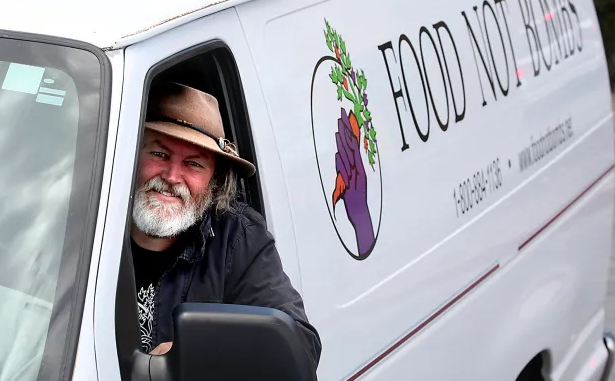
Interview with Keith McHenry of Food Not Bombs
Paul Cudenec: Thanks very much for agreeing to this exchange, Keith. It is very encouraging to know that in this age of near-universal deceit and hypocrisy, there are still individuals out there who stand true to their values. First of all, I gather you have a proud family history of fighting for freedom, going back to the American struggle for independence from Britain?
Keith McHenry: Thanks Paul, at this point there is nothing more important than resisting this rush to the totalitarian police state. Our liberty, humanity and connection to the natural world is at stake and we don’t have much time to stop this catastrophe. Events grow more dire every day so, by the time people read this, the devastation of war, censorship, famine and digital slavery may be so severe many in our audience are likely to feel hopeless, but hang in there! This could be a transformation even larger than that of the American Revolution.
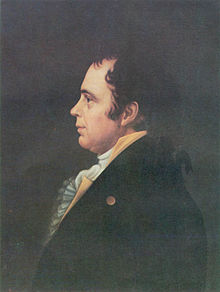
Yes, the first member of my family to arrive in North America was a young James McHenry who stepped onto the docks at Philadelphia in 1773. I grew up knowing that he had been on George Washington’s staff during the war. Family history claims a 20 year old James was recruited into the uprising by Dr Benjamin Rush when James was his medical student. James was tasked with starting a field hospital in Cambridge Port in preparation for what became know as the “Battle of Bunker Hill” and met George Washington there. Dr James McHenry was at the surrender of British general Cornwall at Yorktown, participated in the Continental Congress signing the US Constitution as a delegate of Maryland, was Secretary of War under Washington and Adams. There is a fort in Baltimore Harbor named after him where the text of the US National anthem about bombs “bursting in air” was written by Francis Scott Key during the British bombardment during our war of 1812.
Washington wrote of my ancestor at the low point in the revolution during the winter at Valley Forge: “McHenry’s easy and cheerful temper was able to bear the strain which we suppose must sometimes occur between two persons thrown so closely and so constantly together in a position of social equality and military inequality.” Those who know me may say I also have a cheerful temper.
On the other hand I had a grandfather who dedicated his life to defending corporate power. My mother’s father volunteered to join the Office of Strategic Services, the precursor of the US-CIA. He directed the globe’s most deadly bombing campaign, burning as many a million civilians to death in Tokyo in Operation Meeting House. When I was a child I watched him argue over the phone with his military friends Robert McNamara and Curtis LeMay demanding they drop the nuclear bomb on Hanoi as he swaggered around his office surrounded by photos of his raids on the Japanese city.
These two relatives helped shape my belief that I need to dedicate my life to ending corporate power and at the same time showed me that a mortal like me I could have an impact on the direction of society.
PC: It took me quite a while, as a young man, to find my way to anarchism, but I understand you got there at a very early age! How did that happen?
KM: My first step in my evolution to adopting the ideas of anarchism really started in the ancient Hopi village of Old Oribi in what is now Arizona. My father’s father had lived with the Hopis during the Great Depression, becoming friends with the elders of the 2,000 year old stone pueblo. I was witness to the Snake Dance where young men held rattlesnakes in their mouths as the community watched from the roof tops above the dusty plaza. Large drums roared at one end. At the end of the dance, the boys who had just become men handed food to their audience who, like me and my family, were perched on the mudded roofs of the rock homes surrounding the dance floor. This was before electricity had arrived in these majestic lands.
“I was witness to a vast wilderness free of the modern contraptions of murder and sterility”
My family also sat on the rim of Glenn Canyon and watched the cement trucks hugging the far wall descending to the mighty rapids to dump their loads into the foundation of a dam on the Colorado River that would, once it was completed, flood hundreds of Anasazi cliff dwellings, beautiful rock ruins I would be one of the last people to see. I was five and six when I stood on the edge of Second Mesa at Walpi hundreds of feet above the burial grounds. The spirits of those whose centuries of graves lay below bathed me in a warm golden wind of eternity, flooding my essence with a feeling that I would always be one with the cosmos. I was witness to a vast wilderness free of the modern contraptions of murder and sterility. That feeling has never left me.
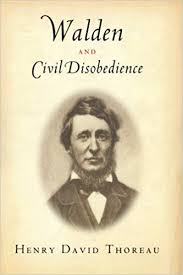
A few years later when my father was a ranger stationed at Shenandoah National Park in Virginia he gave me a copy of “Walden” by Henry David Thoreau. I had just learned to read so I started with the shorter essay in the back of the paperback called “On Civil Disobedience” and that snippet of inspiring text, “I heartily accept the motto, ‘That government is best which governs least’; and I should like to see it acted up to more rapidly and systematically” changed me.
I read that life-changing text when I was in the fifth grade. The Vietnam War was raging. Like many American families we ate dinner while watching the chilling images of the bloody conflict in Southeast Asia with those body count numbers on the evening news. My mother’s brother who I adored was eager to join in the tragedy as a paratrooper. He was spared that horror because he contracted hepatitis in basic training and was hospitalized. The failure to live and die in the jungles as a hero doomed him to a life of self-hate.
Another relative was stationed at the national morgue and gave our family a drive through the Dover Airbase where I was witness to the huge stacks of shiny tin coffins that marched along the tarmac like rows of city blocks. Block after block of caskets waiting to receive the bodies of America’s dead youth.
I lived in the racially segregated town of Luray, Virginia at a time when “colored only” and “whites only” signs were sold at the local Five and Ten shop on Main Street. The murder of Martin Luther King Jr and the riots that followed was another influence that made Thoreau’s night in jail as a tax resister have relevance. Our family happened to head out on a vacation from our home, passing a burning Washington DC and Baltimore and a journey through the black neighborhood of Philadelphia under military occupation. Tanks, gatling guns and helmeted soldiers armed with M-16s and angry german shepherds made an impression. Smoke from the uprising filled our hotel room that evening.
So when I read Thoreau’s argument in his lecture “On Civil Disobedience”, explaining that he had refused to pay his poll tax because he would not contribute to the funding of the Mexican war and a slave state, I saw the similarities to my own time and adopted core aspects of his philosophy.
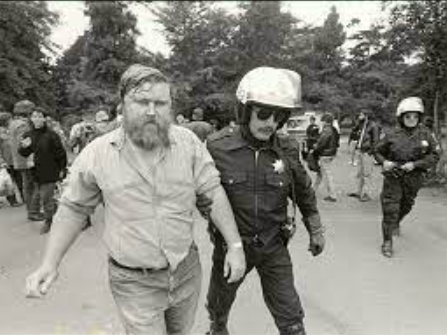
When I was 14 years old I took my first job cleaning an art gallery. I recall being so happy that I had joined the fellowship of working Americans as I sat on a step of the building across the street eating my first lunch of peanut butter and jelly sandwich. That was also the moment I vowed to never pay for war and started my journey as a tax resister and free person untethered to the state. I was also determined to create my own version of Thoreau’s Concord of seekers. Food Not Bombs became my global Concord. I would cast off the use of my Social Security number after my first arrest when I was 18 years old and lived free from the clutches of the State.
PC: Could you say a little bit about Food for Bombs, how that came about and what it aimed, and indeed aims, to do?
KM: Food Not Bombs is a global all-volunteer movement that protests war and poverty by taking direct action. Our people share the gift of food with anyone, without restrictions, while reclaiming the public commons. We are independent of state and corporate power. Our activists recover food that can’t be sold from groceries, bakeries, farms and distributors, prepare vegan or vegetarian meals that are shared on the streets behind the banner of Food Not Bombs.
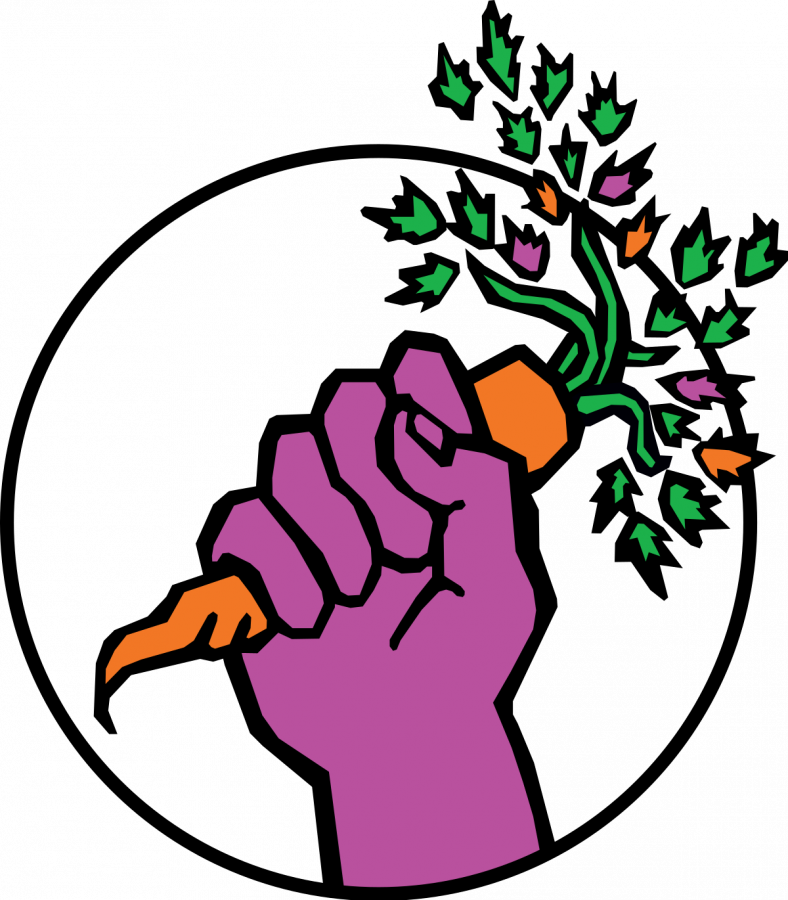
Our main goal besides meeting the needs of the poor is to influence the public to take action to force the state to redirect our resources from the military to provide access to healthy food, safe housing, education and healthcare. We are a classroom that practices the philosophy of anarchism without the dogma of the fashion anarchist.
The first collective came together at an anti-nuclear action in New Hampshire, “The May 24, 1980 Occupation Attempt of Seabrook Nuclear Power Station.” A friend, Brian Feigenbaum, was arrested at the protest and we were able to secure his bail from someone with means. On the way home we agreed to hold bake sales to pay the contributor back. That turned out to be a slow way to raise money. We also had a moving company called Smooth Move and one family we were helping was tossing out a copy of the poster “It will be a great day when our schools have all the money they need, and our air force has to have a bake-sale to buy a bomber”. This gave us the idea to buy surplus military uniforms, set up our poster at our bake sale and tell those walking by that we needed help buying a bomber. This got the attention of pedestrians who otherwise would have rushed past, giving us the opportunity to speak to them about the threat of nuclear war, poverty and hunger.
In 1979 and 80 I was a produce worker at a natural food grocery called Bread and Circus in Cambridge, Massachusetts. I took the produce that was wilted or bruised and could not be sold to several families living in public housing on Portland Avenue. One day one of the mothers pointed out the construction of the new glass building across the street from their crumbling housing, noting that it was about to be completed and that scientists who would be designing nuclear missiles would be moving in. This gave me the idea for the name Food Not Bombs.
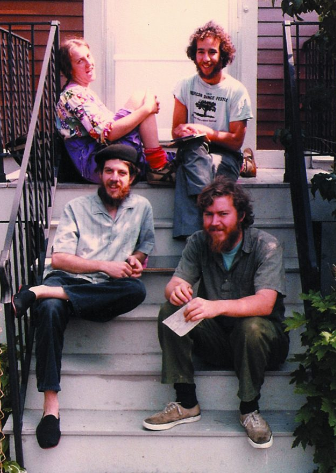
The street theater of our bake sale was so effective at engaging people who walked past in conversation that we adopted the street theater ideas of the Living Theater. We also started a campaign against the banks who financed and would profit from the construction of the Seabrook Nuclear Station. The First National Bank of Boston was our main target and when we learned that their stockholders meeting would be held on March 26, 1981, at the Federal Reserve Bank we decided to protest by setting up a soup line on the Atlantic Avenue sidewalk outside the towering facility. We asked our friends to join us at a “soup line” dressed as Depression Era hobos with the intention of giving a visual example of the future we would face if we failed to stop the policies of Ronald Reagan, the nuclear industry and banks. The night before the action we realized we had not recruited enough people to look like a soup line so I went to the last surviving homeless shelter from the days of the Great Depression. I spoke with those sitting around the bleak tile room of the Pine Street Inn about the protest. Some recalled their participation in the protests against the Vietnam War and expressed excitement at attending. The next day nearly everyone I had spoke with joined us. Pedestrians rushing past said they were surprised to see a soup line just a month after Reagan had become president. The guys from the shelter told us there was no food for the homeless in Boston and suggested we set up every day. That evening we agreed to do just that.
I started a second group in San Francisco in 1988. The police made 94 arrests of our volunteers for sharing food without a permit that summer. I would learn some 35 years later that the FBI Joint Terrorism Task Force had sent a memo to the San Francisco Field Office about the August 22 arrests, claiming Food Not Bombs was “a credible national security threat”. The arrests sparked interest in other cities so I took my notes on how I started the San Francisco group and made a flyer, “Seven Steps to Starting a Local Food Not Bombs Group” and mailed it to those who wanted to start a chapter in solidarity. During the next few years the city would make a total of 1,000 arrests and with each wave of repression more people would respond by starting their own local group. I also made a point of letting people know they could use the carrot and fist logo and any other Food Not Bombs images or texts without restriction.
I was arrested 94 times between 1988 and 1994 and was framed on three violent or serious felonies and faced 25 years to life in prison, spending a total of 500 days in jail. Volunteers were beaten by the police and our food was seized and tossed out. We organized a system to reduce the loss of meals using decoy buckets with tiny amounts of food.
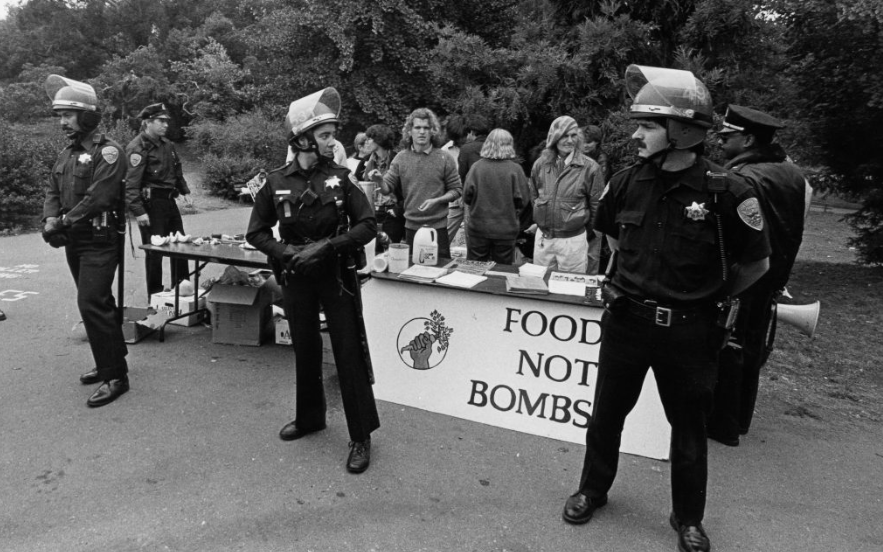
These arrests in San Francisco, followed by arrests in Florida, inspired the formation of more chapters. Today there are at least 1,000 groups in over 65 countries. We provided the food aid to the survivors of Hurricane Katrina and hundreds of our volunteers helped with Hurricane Sandy. Our volunteers also provided food and material relief after super Typhoon Yolanda smashed the Visayas region of Philippines.
Food Not Bombs has also provided food and logistical support for direct actions to defend the environment, indigenous sovereignty, strikes, anti-war actions, Occupy and many other anti-globalization protests including the WTO blockades in Seattle in 1999 and Cancun.
“We need to take action against the ‘Build Back Better’ stakeholder capitalism policies of the WEF, the WHO and other global corporate institutions”
Maybe the most impressive action we inspired was the uprising against the corrupt government of Iceland that resulted in the collapse of the political leadership and the jailing of several bankers. It is clear to me that Food Not Bombs must step up our organizing efforts as the planned economic calamity of 2022 will make the 2007 financial crisis seem minor by comparison.
Our four decades of organizing against international economic policies takes us to the point where we are today, where we need to take action against the “Build Back Better” stakeholder capitalism policies of the World Economic Forum, the World Health Organization and other global corporate institutions. There is a continuity in our founding resistance to corporate plunder and its ravages of poverty and war outside the Federal Reserve Bank in Boston and our resistance to the trans-humanist totalitarian technocratic globalist policies threatening our humanity and Earth today.
PC: What projects were you involved in at the start of 2020 and what was your initial reaction to the Covid moment?
KM: I had just returned from three weeks in Guatemala where I had been writing a book about my life when news came that a deadly pandemic was about to sweep the country. I had intended to continue writing and help with the preparation and sharing of our weekend meals but that changed four days after my arrival in Santa Cruz, California.
When we learned that the indoor meal programs for the homeless and poor had been ordered to close on March 14, my local Food Not Bombs group agreed to fill that void. If we didn’t start sharing food and water with the unhoused community, hundreds of our friends would go hungry and suffer from a lack of drinking water.
That morning we met to formulate a plan on how to share meals safely under the reported conditions. We moved our weekend meal to the Clock Tower, a public plaza across the street from where we shared our normal weekend meal because about 20 people were camping up against the fence that protects the Post Office from the homeless. We didn’t think it was wise to have a line of over 100 people standing so close to people and their tents.
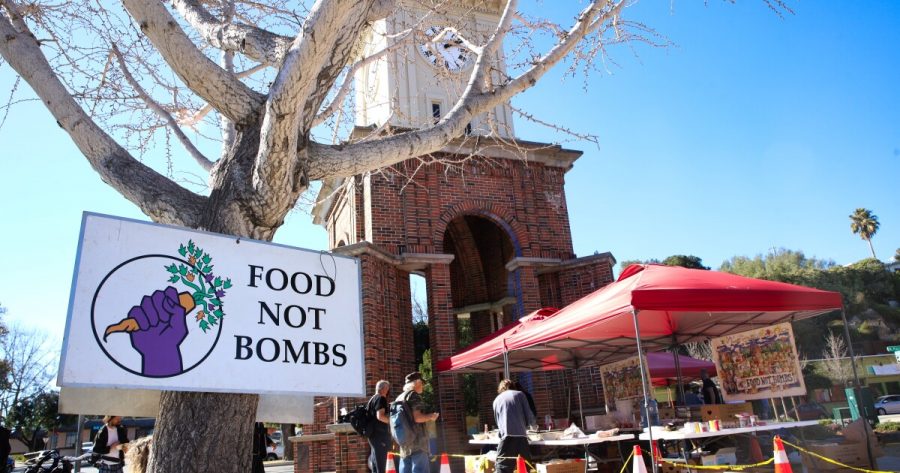
Like many other people in our group, I had the impression the crisis would last a month or so and the other food programs would reopen. That was at a time when the authorities were claiming we needed “two weeks of quarantine to flatten the curve”. So we set up a daily meal, our DIY hand washing station and a distribution of survival gear in solidarity with our local homeless organization, calling our project the Santa Cruz Homeless Union COVID-19 Relief Center and Food Not Bombs meal.
I remember being impressed to hear that many of my unhoused friends found that the lockdown was liberating. Everyone, housed and unhoused, was united in this chaos. Many people who lived in the streets told me on day one that they thought the whole fear story was a scam and nearly every unhoused person who I spoke with claimed that their rough life would make them immune from any plague. None of my homeless friends worried about getting COVID. The only concern they had was being able to get drinking water and something to eat.
It seems crazy now but in the first weeks of the pandemic we had an aggressive policy of wiping down our tables and our delivery van with bleached water. We wrapped caution tape looped through large yellow Trader Joes grocery lugs that we placed around our serving tables to add distance between the servers and the people coming to eat. A week later we spray painted white dashes in six-foot intervals for social distancing along the sidewalk leading to the serving area. The police claimed the virus could be passed from person to person if we continued the practice of letting people rummage through our clothes donations and, to avoid being shut down, we had volunteers hold each item up so our friends could decide if it was something they would need.
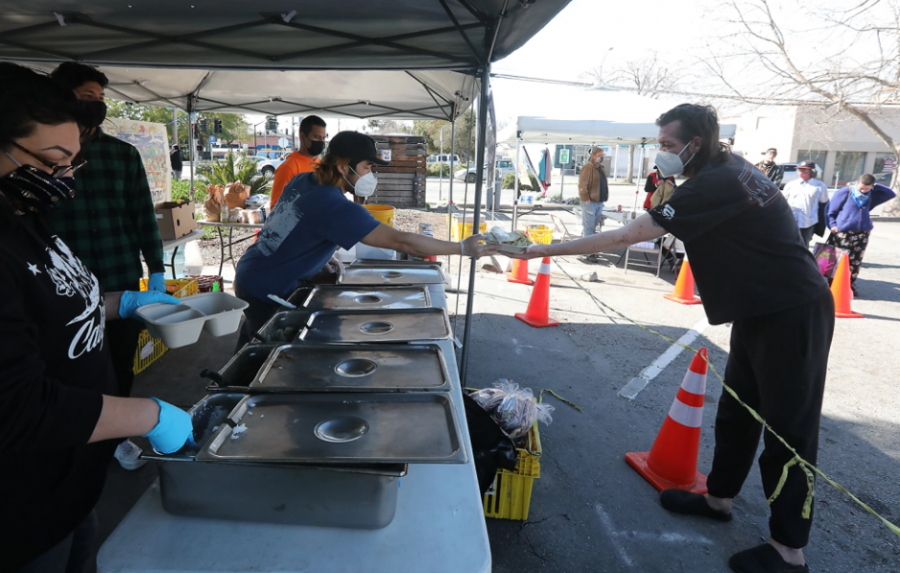
That same week the City erected homeless triage centers in downtown parking lots that were nothing more than chain-linked cages with a couple of portable toilets. The mayor of the city stopped at our meal and asked us to move to a location where we could help them lure the unhoused into their cages. I refused. I wouldn’t let them use the trust we have with the unhoused to intern those who live outside. They abandoned their program a couple days later after they realized the unhoused were not interested in cooperating. The governor of the state announced that the government would provide millions to buy or rent hotels for the homeless to quarantine but our city and county refused to take them up on the offer, even though we are a tourist town and the hotels were nearly empty. Our city leaders have been vocal about the unhoused being less than human and not worthy of help, which was at the core of their refusal to move everyone inside.
I remember thinking this could be the beginning of an economic collapse and that we needed to prepare. It looks like I wasn’t far off the mark. Our Food Not Bombs chapter ordered a truck load of dried goods from Second Harvest Food Bank. Twenty or more pallets of rice, beans and can goods were unloaded outside the kitchen we were renting at the time. But the county government took over the facility to shelter a couple dozen unhoused people in pup tents lined across the auditorium above the kitchen. We had to find a new place to cool and moved our pallets of food to a closed restaurant and a 20-foot refrigerated shipping container we had secured a year before with a grant from the food bank.
My girlfriend Kathleen was a social worker at two local hospitals. Patients said to have COVID were wheeled down the hallways under plastic tents on their way to a COVID floor. The first days had a feel of a dystopian science fiction movie. Radio and TV programs blasted out doom. They screamed that we could all die if we didn’t obey. Nonstop fear. Homeless triage cages, images of body-bagged people being wheeled to refrigerated trucks, health officials standing with Trump announcing emergency measures. We all witnessed the media madness. This was my first tip that there was another agenda other than public health.
It is no wonder those locked into their homes lost the plot. If you didn’t venture outside you would think, from the constant terror on the media, that the streets were littered with the dead.
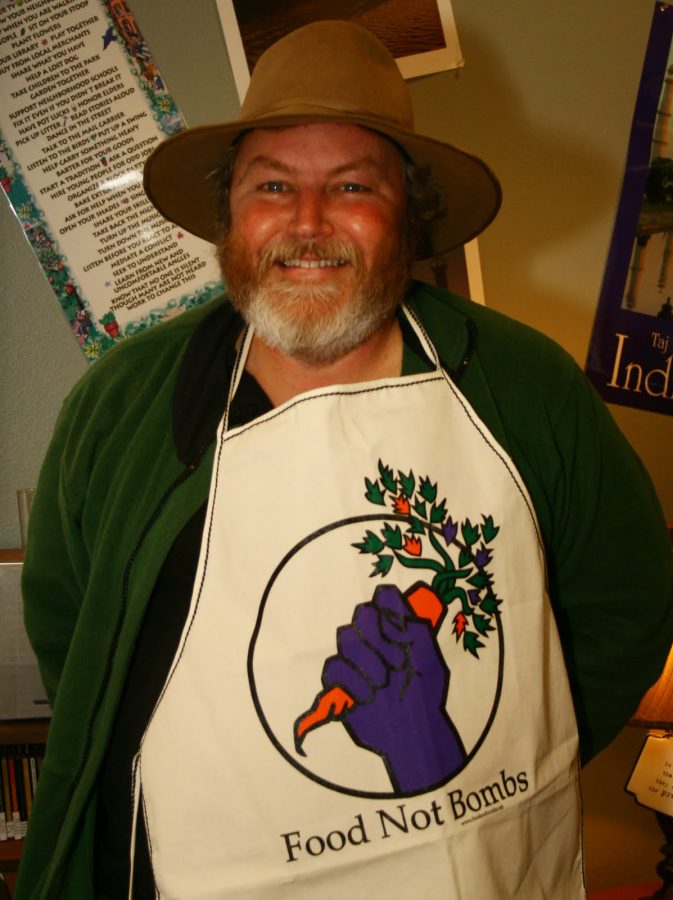
I had just sold my permaculture farm in New Mexico and was given a financial award by a group to honor my dedication to promoting a vegan lifestyle, so I had a bit of money for the first time in my life. In an attempt to build pressure to provide dignified accommodation to those forced to live in the streets, I paid for eighty beds and announced I would be providing hotel vouchers at 6:00 pm that evening. Over 100 people arrived and the crush of desperate people seeking for a chance of a night in a bed and a hot shower was heartbreaking. The chief of police declared it a violation of COVID gathering restrictions, telling the media that we were holding an illegal rally rather than providing a chance to sleep in a hotel for the evening. I was able to pay for two more nights for 180 people and the local shelter asked me to put up half their people on the fourth night. I was investigated by the police for handing out counterfeit hotel vouchers but they never took me to court.
The county government was offered millions to provide hotel rooms but at the height they placed less then 150 of the over 2,000 people who lived outside in their empty motels. This was a sign that they did not value the unhoused as fully human. In the early months of the crisis there were more than 2,000 unused hotel beds in Santa Cruz since tourism was over for the near term.
During the first months of the lockdowns, the streets of Santa Cruz were empty of vehicles. If I happened to pass another motorist I would wave and they would nearly always respond with a nod or gesture of their own. The public restrooms were closed and drinking water was scarce. The only people walking the streets were those who lived outside.
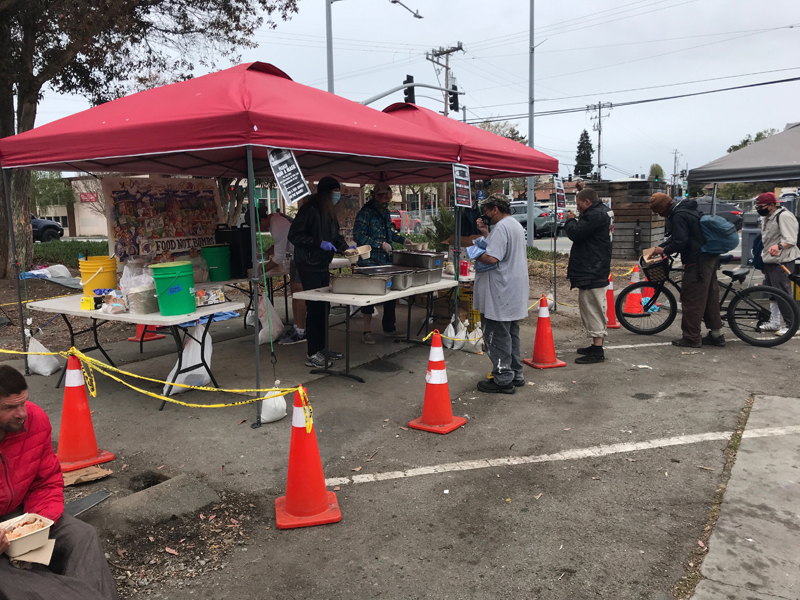
The largest challenge was calming the violence and acting-out of those who were already suffering from mental health issues. The tension was intense in those early days and those people who were already having emotional difficulties really freaked out, making the sharing of our meals otherworldly. Lots of yelling and fights. There were times when I had to step in and keep people from beating someone to death. But we didn’t stop and have been out on the streets sharing food and water with our community for nearly 900 days in a row now. Services that the governments are refusing to provide.
Since we were the only group making sure those who lived outside had food, the public was generous and we were able to buy two more 20-foot shipping containers which we have stocked to the roof with dry goods. We also bought a water filtering system to clean the river water if the electricity failed, which is a real possibility here in the world’s fifth largest economy of California. We also prepared to cook outside in the event that gas is cut off, stockpiling propane tanks and stoves.
There was a massive forest fire that forced hundreds of people from their homes. A thick red smoke blotted out the sun for days. Fire evacuees came to us not only for food but to replace their lost clothing. We also have been giving out cheap pup tents to those who have just moved to the streets or had their vehicle or tent confiscated by the city.
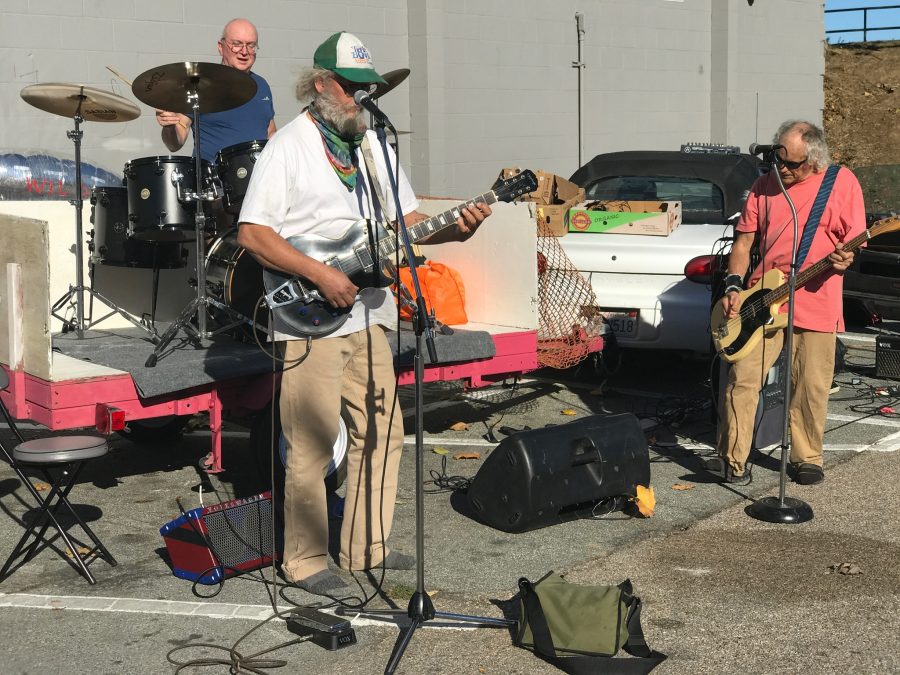
We defied the fear with our introduction of a free solar-powered concert at our meals during each holiday. People danced to the live music and enjoyed each others’ company. While most people were isolated in their homes receiving food from delivery services while glued to their computer screens, our poor and homeless friends were free. In the first two years only two of my unhoused friends reported contacting COVID. Crystal worked nights at a shelter and she felt ill for two days. Dream Catcher slept at the shelter and was sick for a week. Everyone else I met who said that they had caught the dreaded disease lived inside and did as they were instructed. They had cowered before their TVs and computers and resisted the temptation to interact with other humans.
We frustrated the authorities with our gatherings but there was little they could do. The jails were full and when they did arrest our friends the police released them as soon as they arrived outside the jail gate. The courts were closed for nearly a year so we ignored our charges and went on with our lives. I remember one of our homeless volunteers was ticketed for violating the quarantine. His citation was for $1,000 and his address was marked as “transient.” He ignored it, other than to show it around to highlight the insanity of our times.
We were free. We weren’t afraid.
The Homeless Persons Healthcare Project has been aggressively injecting people, offering the unhoused $50 gift cards. It has only been in the past few weeks now that my homeless friends have started to report that they are very ill with COVID. All of those I meet who now have COVID have been injected. None of my unvaccinated friends have been ill with COVID in over a year now.
PC: So all this changed your overall understanding of the situation? How would you now describe what has been happening over the last couple of years?
KM: In the first weeks of the pandemic I feared for the worst. I recall posting negative comments about those who questioned the official narrative at first but the fear narrative around COVID was being pushed nonstop in the media, suggesting there was more to this than public health. I was also witnessing that no one I knew who, according to the screaming media should be dying, was ill. Each day I saw that the only impact was closed stores, empty streets and shuttered food programs increased my belief that the pandemic was not as severe as advertised.
“Since I have been the direct target of covert disruption by state intelligence agencies for the past four decades I am naturally suspicious of official narratives”
When Trump announced the Operation Warp Speed, that got my attention. A military program coordinated with some of the largest pharmaceutical companies in the world suggested there was more to this drama than concern for public health. The endless announcements that each program was sponsored by the Bill and Melinda Gates Foundation didn’t add to my confidence that this hysteria was based in reality. I had spent the past two decades organizing against the Gates of the world and the patenting of his GMO seeds with groups like the Organic Consumer Association.
Since I have been the direct target of covert disruption by state intelligence agencies for the past four decades I am naturally suspicious of official narratives. The media lied us into war after war so this had the same feeling as the WMD of Iraq, the babies taken from Kuwaiti incubators, the Gulf of Tonkin incident and other disinformation campaigns of the past.
It wasn’t long after that that one of my closest friends, Dr. Shannon Murray, came to Santa Cruz to visit Kathleen and me. She was on her way to start a new life since her employment as a scientist had vanished. She is a virologist and an expert on gain-of-function research.

I knew her when she was helping develop the Moderna vaccine at the National Institute of Health in Bethesda, Maryland. She feared there could be major health problems from the vaccines since the first human trials had not yet taken place and more study was needed before they could be considered safe. She shared that the animal trials had not been promising, killing nearly 80% of the vaccinated animals who were exposed to SARS-CoV-1. She also expressed concern that research in these vaccines had abruptly become a secret military program, sharing that her access to data had suddenly gone dark in January. At that time she was still using an alias, as did her coworkers, so they could share their concerns without fear of being banned from their life’s work or murdered like former Merck Pharmaceutical sales executive Brandy Vaughan, who was killed just as the pandemic was being announced. Like some of those she worked with at the NIH, Shannon refused to get the COVID jab and encouraged us to refuse as well.
As I said, my girlfriend Kathleen worked at a local hospital with a COVID wing. As the days passed she failed to see the deaths suggested by the news. Sure, many elderly people filled the section but few succumbed to the virus. Once the vaccine program began she would return home to share one story after another of the stroke and heart attack patients who had just received their first jab. Those injected were fast becoming the people who filled the ICU unit. They were the ones leaving in the body bags.
Sharing food every day outside also made it clear that the official story was false. Every day a hundred or more people would gather together to eat. No one said they had contracted COVID or shared that they had the symptoms. The deaths of our friends came at the end of a needle of fentanyl-laced heroin and meth or from the brutality of a life lived unprotected from the elements.
“It seemed every leftist friend had retreated to their apartments in fear of dying”
When I saw people the media called anti-vaxxers armed with AR-15s waving confederate and Trump flags at protests against the lockdowns I was horrified. There is no way I would ever join people like the Proud Boys and Trump supporters in demonstrations against COVID policies. The questioning of Dr Fauci was framed as a position taken only by racist gun-toting Trump supporters, effectively driving my friends in the left into the arms of the military and big Pharma. It seemed every leftist friend had retreated to their apartments in fear of dying.
I had the impression I was one of only a couple of progressive activists that thought something wasn’t right. I would slowly learn that several other left friends also shared my perspective. I connected Shannon with an old journalist friend, Sam Hussini, who had been writing on gain-of-function research and bio-warfare programs at places like the Fort Detrick Biological Warfare Laboratories. I learned that another colleague of mine, the director of the Organic Consumers Association, Ronnie Cummings, and my associate Vandana Shiva were also expressing concerns that mirrored our work together against Monsanto. So even though I remained publicly silent, worried my opinion could cause harm to the Food Not Bombs movement, I started to feel less alone. This was the era where, in desperation, I started to post cryptic messages about understanding how people like the artists Käthe Kollwitz must have felt as everyone she knew seemed to have signed on to the National Socialist agenda during the march towards World War Two. I did get some confused comments.
When my dear friend in her 40s messaged me from Australia that she almost died from myocarditis I could not be silent any more. That was the last straw and I became a vocal opponent of the jabs.
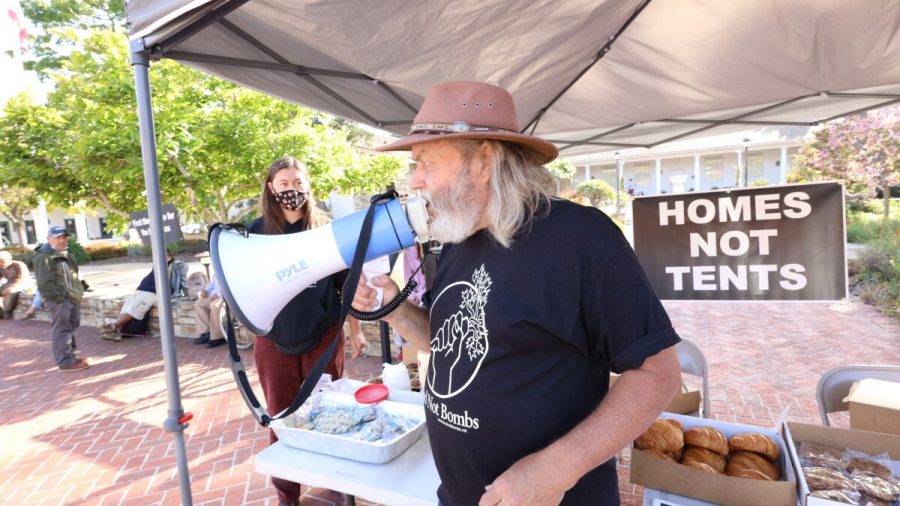
I first wrote a letter on this subject when I received an invitation to attend a meeting forming a new progressive alliance. To participate you had to provide proof of a vaccination or a negative COVID test. I wrote to invite the progressive community to stand in solidarity with the working class by refusing to meet in facilities that demand proof of participation in the vaccine experiments. Nearly every “essential worker” I depended on for auto repair, printing and other supplies shared my perspective on the COVID clampdown. The left I had known stood for workers’ rights during the first four decades of my life, but that had changed. We had become tin foil hat deplorables even though those smearing our position depended on us to provide their needs.
Before the invitation to this meeting asking me to help start a new progressive group, I had shrugged off the proof of vaccine requirements. I ignored the proof of vaccination requirement for attendance to the American Civil Liberties Union awards ceremony since I couldn’t go anyway because I had to cook that day. I later learned that the outdoor venue for the meeting did not require this proof, nor did the Simpkins Family Center where the progressive alliance was intending to meet. My allies were the ones implementing this policy. Allies I know had been sitting at their computers during the entire pandemic and rarely went outside to see reality. One of the organizers kept trying to get me to be “an example for the community” by getting “vaccinated”. I patiently explained the reasons I would never subject myself to the poison but he continued to pressure me.
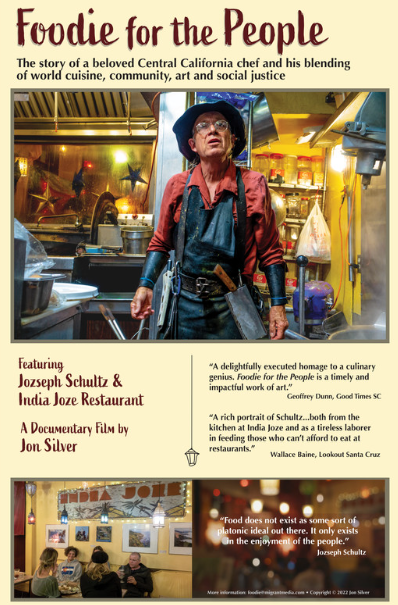
I also had friends that were eager for me to attend the opening of the documentary “Foodie for the People” that had a section that featured me and the work of Food Not Bombs. The filmmaker was excited to tell me that he used a clip from his interview with me to promote the film. The announcement for the film required proof of vaccination or a negative PCR test. But I also learned that Del Mar Theater, where the movie was being shown, didn’t require proof of vaccination or a negative test yet those showing the movie had made it a requirement.
The final insult was the day I went to my favorite activist cafe and was told I could not enter unless I could show proof of vaccination. That was it. I had been outside nearly all day, every day of the pandemic. I never spent a second inside being quarantined. I could see the reality of the pandemic with my own eyes. I couldn’t remain silent any longer.
I wrote an essay, “Looking at COVID as a Progressive” that I posted online and emailed it to the community. That broke things open. By the end of the week I started to get emails and calls of relief from friends who had been silent, believing they too were alone in feeling that the pandemic restrictions were part of a power grab.
One of the most discouraging aspects of the psychological operation was to see posts by Food Not Bombs groups promoting the vaccines and masks. One New York chapter shared an announcement that people could come to our meal and get vaccinated under the headline SAFE – EFFECTIVE – FREE. Another chapter posted an announcement to an outdoor protest in late June 2022 with a large type demand to “Wear Masks”. To see the movement I helped start actively support a totalitarian corporate agenda has been heart-breaking.
PC: Are there now many others in your circles who share your dissident take?
KM: Thankfully several of my close housed as well as unhoused friends are on the same page. As I pointed out before, my many of my homeless friends didn’t fall for the fear campaign right out of the gate. I was heartened when I watched The Convo Couch podcast early in the crisis and heard Pasta and Fiorella express the same bewilderment at our friends and allies pushing the agenda of those we had spent years organizing against. Glory and Steve at the Slow News Day also expressed amazement at the way in which those who once stood with us in the issues of workers’ rights, resistance to mega corporations and the military had become vocal defenders of those threatening our freedoms. After I posted “Looking at COVID as a Progressive” my circle doubled.
PC: Two things surprised me about the reaction of the rump of the left, including anarchists, to Covid. The first was the position they took, completely accepting the official line and supporting masks, lockdowns, social distancing and injections. The second was the way that this was not just an opinion, but an article of faith which had overnight somehow become ideologically essential. If you questioned government, opposed Big Pharma, exposed the links between the two or stood up for individual freedom, you were suddenly considered “right-wing”! The vitriol and vehemence with which I was attacked really shocked me. Did you experience anything like that?
KM: I have often been called a Trumper or right wing by my anarchist and other left friends during this insanity. People are not so bold any more but for the first two years people said they were shocked that I had become a far right Republican Trump follower since I had been known as an anti-war leftist. I think the fact that I have been out on the streets for nearly 900 days, sharing food when the state provided nearly no support at all for the unhoused, has made it difficult for local people to express this opinion openly to me. I am also seeing less of these direct attacks on social media now. I find it interesting that my allies in the anti-globalization and peace movements do not see a connection between our protests against the Weapons of Mass Destruction lies before the Iraq war, GMOs, a woman’s right to choose abortion and big Pharma but now are public about supporting forced vaccination, censorship, and the war in Ukraine.

PC: I have spent a lot of time trying to work out exactly why the left/anarchist scene collapsed so dramatically as a force for resistance in the Spring of 2020. Do you have any thoughts on this?
KM: Based on my having survived four decades of state and corporate intelligence agency disruption, I believe I have an educated guess. It looked like there was an effective strategy linking covertly controlled far right groups waving Trump and Confederate flags and AR-15s with opposition to the COVID policies. I know I didn’t witness any other left anarchists denouncing the policies in the first months so like many others who may have shared my perspective I thought I was alone. The headlines of most corporate media blasted stories like “Coronavirus: Armed protesters enter Michigan statehouse” with the media showing footage of protesters outside state houses chanting “Let us in!”, “Let us work” and “This is the people’s house, you cannot lock us out”. Before COVID, unarmed leftists would have been the ones chanting these slogans but the images of Trump-supporting, gun-toting anti-lockdown protesters helped shape the narrative. In the early days of the crisis, the Los Angeles Times had a story showing a Proud Boy Nazi with swastika tattoos stabbing a pedestrian during a lockdown protest.

But this is only one of the many aspects of the psychological operations that was effective. The use of media to repeatedly claim isolation, masking, social distancing and shots were all about protecting the community and for the greater good of all, fed into some of the core beliefs of the left. No self-respecting leftists wants to be accused of being selfish.
The left also did not want to be anti-science and since all alternative ideas were censored or attributed to tin foil hat Qanon Trumpers it became a badge of honor to smugly sneer at those ignorant hillbilly deplorables.
I also think that those in power were clever and their foundations started to fund a loyal opposition with haste when the Democratic Party chose Biden as the leader of the regime. One of the first reports on the popular left program Democracy Now! featured Peter Daszak of the EcoHealth Alliance claiming a bat virus in a Wuhan wet market was the likely source of the Pandemic. My friend, investigative journalist Sam Husseini, was never asked to refute Daszak’s claim even though Sam had several articles published in April 2020, on the history of gain-of-function releases at American-funded bio-weapons laboratories, a dramatic subject that would have interested Amy Goodman before the crisis. The host Amy Goodman breathlessly reported on the refrigerator trucks outside New York City hospitals. She was all in on the official COVID narrative and that has had a major influence on the American left.
“The funding of the non-profit industrial complex is often a means of controlling dissent in the United States”
Foundations have helped to coopt as many left organizations as possible. Most of our allies accepted their support, surrounding the left with community groups who danced to the tune of Gates, Soros and other philanthropists. The funding of the non-profit industrial complex is often a means of controlling dissent in the United States. The messaging was unified and total. It was intimidating. My early posts of “I always support secret military programs and Big Pharma”, in my ironic response to social media demands to comply with the totalitarian program, were either mocked or commented on with confusion. Reminding activists of our struggle against the World Trade Organization and its direct line to the proponents of a digital slavery of vaccine passports, and other programs of globalist associations like the World Economic Forum and The World Trade Organization, seems to have evaporated with the fear of COVID and the potential of being mocked for not going along with the crowd.
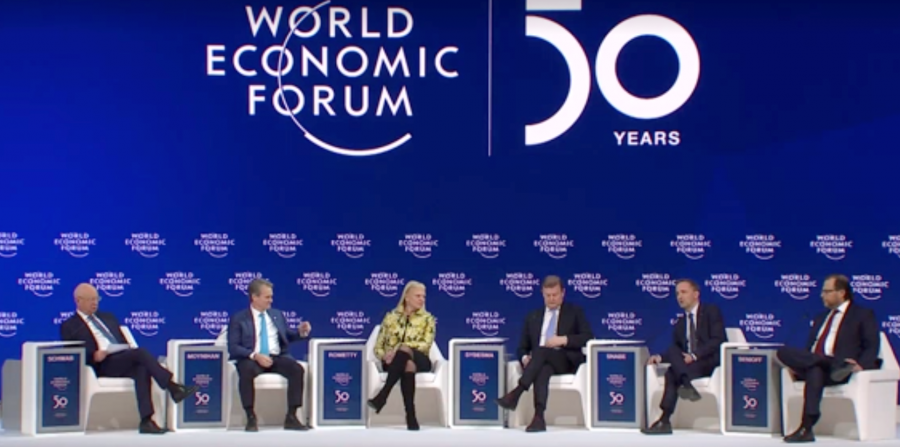
PC: How do you see the relationship now between the likes of you and me and those we previously called our comrades? Have the division lines softened at all over recent months, as you maybe hinted, or are we looking at a decisive rupture, do you think?
KM: It could take many years for a large portion of our allies to join the struggle even as they are forced to participate in an ever-increasing digital slavery. The impact of Mass Formation has been effective. But there is some hope. I often attend a Freedom gathering on Sunday afternoons and of the 30 or 40 people who participate at least half are left activists and the other half are Republicans. I am witnessing a shift where people on the left are now silent about anything to do with COVID and are starting to focus on the economic collapse and the dire conditions we face. Many are even starting to become quiet about their worship of Zelensky now that a Ukrainian victory is less certain. They are not ready yet though to connect the COVID program and war to the march towards the Great Reset. As events spin out or control, it is possible there will be some unity around some aspects of the Great Reset if it is presented as an attack by global capital, but the mask/vaccine area of this program may be impossible for our friends to see and they may continue to support things like censorship, digital passports and mandates. It seems that even as my fully vaccinated friends keep getting COVID or die of strokes and heart attacks, they are so wedded to the narrative that they are not able break out of the trance.
PC: How should we go forward from here? How can we best build new alliances of resistance without compromising our core values which, for me at least, remain exactly the same as they were before Covid?
KM: This is a tough question in light of the global chaos and successful divide and conquer strategy of capitalism. One path is to build local systems of mutual aid so we can survive. The war on thought is unrelenting. Building local communities that support one another emotionally and with the necessities of life may be our only alternative. Food Not Bombs history may provide some guidance. We have intentionally formed a non-hierarchical decentralized system of organizations that seeks to address the needs of the community. Housing with Homes Not Jails, transportation with Bikes Not Bombs, Food Not Lawns, Free Radio, Composting, and of course the food of Food Not Bombs. The other key idea one could take from 42 years of Food Not Bombs is a joyous welcoming atmosphere that encourages dialog by providing literature, music and theater with the necessities of survival gear and a hot meal. Evading the violence of the state may be difficult and strategies of self defense need to evolve.
On the points connected to the fear of COVID, many of our former allies may be lost to us for decades to come but on the issue of digital slavery, police repression and the economic collapse we may have some unity. As difficult as it can be, I make a point of being understanding of those who worship the COVID narrative, always make sure they know I am unvaccinated and move my conversations towards our shared history of resisting the corporate exploitation and the economic slavery of the global institutions.
“As free thinkers we can encourage a great transformation of the human spirit where we find solutions outside the left-right paradigm”
The latest preplanned trauma in the United States is centered around the divisive issues of guns and abortion. There is, however, an intersection around privacy and personal autonomy with those who are pro-choice on the issue of abortion and those who want the freedom to refuse the jabs. There should be unity with the principle that censorship is never justified, but so far anarchist are still on the “silencing uncomfortable ideas” train. And there must be universal agreement between the left and right for the need to end war in Ukraine and an urgent demand to ban all nuclear, chemical, and biological weapons.
As free thinkers we can encourage a great transformation of the human spirit where we find solutions outside the left-right paradigm. That discussion and search must continue in earnest. I am done with the left-right divide. It’s now the humans versus the deadly robotic corporate state. My message in my 1992 book “Food Not Bombs, How to feed the hungry and build community” was to organize against the death culture of state and corporate power. That remains my perspective today, only now this fight must find a solution and fast. We need to form a strategy that is difficult for the intelligence agencies to disrupt, builds solidarity and threatens the power elite while nurturing a thriving community. The anarchist theories of decentralized local autonomous social structures I believe are key to survival. Total noncooperation with the system while operating survival projects independent from state and corporate institutions is the path I am taking.
We are nearing a point where the goal may be having food and shelter while avoiding being interned or killed by those loyal to the Build Back Better stakeholder capitalists. As I respond to your questions, I worry these comments won’t reach the public before the first nuclear weapon is launched or we are captured and removed from society for our thought crimes.
Follow Keith McHenry on Twitter via @keith_mchenry

Leave a Reply